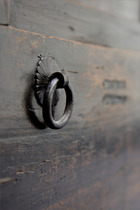Wheeled "kuruma tansu" storage chest, late Edo period, 19th century · Japan · ID: 3046728
Description
elm/ zelkova (“keyaki”), metal fittings with finish in blackened burned lacquer, front with two large sliding doors, two small drawers, one internal shelve, on solid wooden wheels
Consistent with Japan’s minimalist aesthetic, traditional homes appeared rather empty. “Tansu” were not visible in the home except at certain times for specific situations. They were kept in storehouses (“kura”) adjacent to homes or businesses, in storage rooms (“nando”), in house closet alcoves (“oshiire”), on raised platform areas of a shop (“choba”).
For this purpose, the “tansu” had to be transportable, which is why they were made of lightweight wood and could either be carried on shoulder bars or ridden on built-in wooden wheels.
These “kuruma tansu” coffers on wheels are the oldest documented example of Japanese mobile cabinetry. They were the property of wealthy families. In the Edo period (1603-1868) they served noblemen and Samurai to demonstrate their noble status.
The object Wheeled “kuruma tansu” storage chest, late Edo period, 19th century with the object ID 3046728 was part of the auction 94th Tribal Art Auction on March 7, 2020, lot number 109 at that time and is currently available for EUR 5,000 in Open sale.
Here you will find more objects and interesting facts about Asian art.







